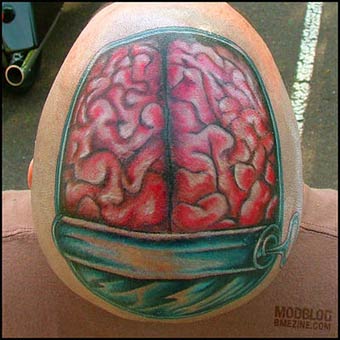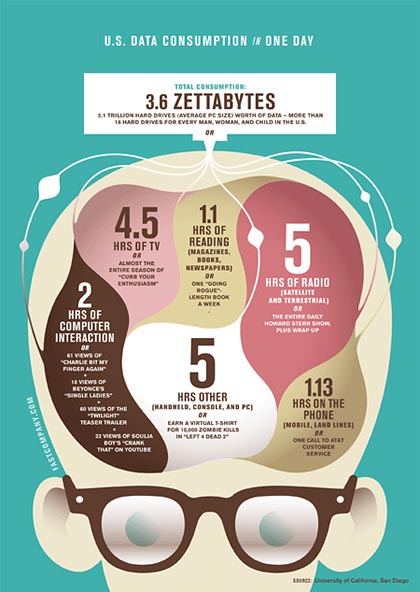brain

As Mr. Tahiri spoke, an Afghan soldier appeared carrying a large red trash bag. It was, he said, filled with human brains. “What do you want me to do with this,” he asked. “Do you want me to bury it, or do you want to take it?”
{ NY Times | Continue reading }
brain, gross, horror | May 18th, 2010 8:32 am

That post was about sleep researcher Jerry Siegel, who argues that sleep evolved as a state of “adaptive inactivity”. According to this idea, animals sleep because otherwise we’d always be active, and constant activity is a waste of energy. Sleeping for a proportion of the time conserves calories, and also keeps us safe from nocturnal predators etc.
Siegel’s theory in what we might call minimalist. That’s in contrast to other hypotheses which claim that sleep serves some kind of vital restorative biological function, or that it’s important for memory formation, or whatever. It’s a hotly debated topic. (…)
Dreams are simply a result of the “awake-like” forebrain - the “higher” perceptual, cognitive and emotional areas - trying to make sense of the input that it’s receiving as a result of waves of activation arising from the brainstem. A dream is the forebrain’s “best guess” at making a meaningful story out of the assortment of sensations (mostly visual) and concepts activated by these periodic waves. There’s no attempt to disguise the shameful parts; the bizarreness of dreams simply reflects the fact that the input is pretty much random. (…)
While Hobson’s theory is minimalist in that it reduces dreams, at any rate in adulthood, to the status of a by-product, it doesn’t leave them uninteresting. Freudian dream re-interpretation is probably ruled out (”That train represents your penis and that cat was your mother”, etc.), but if dreams are our brains processing random noise, then they still provide an insight into how our brains process information. Dreams are our brains working away on their own, with the real world temporarily removed.
{ Neuroskeptic | Continue reading }
brain, science, sleep | April 28th, 2010 11:12 am

Brain injuries caused by strokes, tumors or head trauma can, on occasion, result in Unusual Changes in Sexuality, as discussed in an earlier blog post. A new case report by Bianchi-Demicheli et al. (2010) describes a unique paraphilia in a married 34 year old man. The authors called it Sleeping Beauty paraphilia:
This [man] felt sexually aroused from seeing sleeping women as well as from taking care of their hands and nails while they were asleep.
The patient came to the attention of the authors when he was brought to the emergency psychiatric unit after assaulting his wife with pepper spray while wearing a latex mask.
{ The Neurocritic | Continue reading }
photo { Helmut Newton }
brain, relationships, sex-oriented | April 22nd, 2010 9:12 am

Formation of a memory is widely believed to leave a ‘trace’ in the brain - a fleeting pattern of electrical activity which strengthens the connections within a widely distributed network of neurons, and which re-emerges when the memory is recalled. The concept of the memory trace was first proposed nearly a century ago, but the nature of the trace, its precise location in the brain and the underlying neural mechanisms all remain elusive. Researchers from University College London now report that functional magnetic resonance (fMRI) can be used to decode individual memory traces and to predict which of three recently encoded memories is being recalled.
{ Neurophilosophy/ScienceBlogs | Continue reading }
photo { Sebastian Kim }
brain, science | March 18th, 2010 2:45 pm

Scientists have spent the past decade making great strides in the field of brain-computer interfaces (BCI). By attaching a series of electrodes to a human brain, researchers can feed neural impulses from the brain into a computer to allow the direct control of robotic devices. One major downside, of course, is that the electrodes through which the subject controls these robotic devices have to be placed directly on the brain. This drawback had been in large part considered unavoidable, as electrodes placed outside the skull were thought to gather insufficient information to successfully operate a mechanical device. But in a study published last week in The Journal of Neuroscience, researchers were able to use an array of 34 electrodes attached to test-subjects’ scalps to deduce the subjects’ 3-dimensional hand movements. The importance of this work is clear: It may help patients who have lost a limb to operate a replacement robotic prostheses with their brain.
{ Seed | Continue reading }
related { Brain-Computer Interface Live demonstration of a brain-controlled Adams Family pinball machine | video }
brain, technology | March 11th, 2010 4:46 pm

Removal of specific parts of the brain can induce increases in a personality trait which predisposes people to spirituality, according to a new clinical study by Italian researchers. The new research, published earlier this month in the journal Neuron, provides evidence that some brain structures are associated with spiritual thinking and feelings, and hints at individual differences that might make some people more prone than others to spirituality.
{ Neurophilosophy/ScienceBlogs | Continue reading }
brain | March 4th, 2010 6:10 pm

Psychologists have used an inventive combination of techniques to show that the left half of the brain has more self-esteem than the right half. The finding is consistent with earlier research showing that the left hemisphere is associated more with positive, approach-related emotions, whereas the right hemisphere is associated more with negative emotions.
{ BPS | Continue reading }
Iain McGilchrist has recently published ‘The Master and his Emissary’ a book which posits that the division of the brain into two hemispheres is essential to human existence, making possible incompatible versions of the world, with quite different priorities and values.
{ Interview | Frontier Psychiatrist | Continue reading }
illustration { Kristian Hammerstad }
brain, halves-pairs, psychology | March 3rd, 2010 5:41 pm

One of the most interesting things we learned in Artificial Intelligence is that what we consider hard, like chess and multiplication, is easy for a computer. What we consider easy–like recognizing emotions on faces, or visually distinguishing between a dog and a cat–a computer finds quite difficult. What is hard for us, is only because we know the right answer, and know how difficult it is to do the logic in our head. Most thoughts we take for granted are really quite complex, yet because we can’t even begin to write down how we do it, we do not realize it.
{ Falken Blog | Continue reading }
photo { Robert Whitman, 80s my livingroom }
brain, experience, ideas | February 25th, 2010 9:05 pm

“How we process information is related not just to our brains but to our entire body,” said Nils B. Jostmann of the University of Amsterdam. “We use every system available to us to come to a conclusion and make sense of what’s going on.”
Research in embodied cognition has revealed that the body takes language to heart and can be awfully literal-minded.
{ Natalie Angier/NY Times | Continue reading }
brain, psychology, science | February 4th, 2010 9:21 am

The relationship between emotions and rationality is one that has preoccupied man for thousands of years. As the ancient Stoics said, the emotions typically involve the judgement that harm or benefit is at hand (Sorabji 2006). Already, then, there was thought to be a relationship between emotions and ‘judgement’, the latter implying a degree of rationality. But Sorabji, a philosopher, also points out that the mere intellectual appreciation of benefit or harm does not constitute emotion, but there must be some physiological disturbance: disembodied emotion is not meaningful. Yet the physiological reactions involved in emotions are typically thought of, since the development of evolutionary theory, as something of more primitive origins than reasoning. One reaction to this would be to argue that emotions govern actions that are urgent and essential to survival, whereas reasoning is dispassionate and calculating. (…)
To understand the usefulness of neuroscience in examining the rationality of decision-making, it is worth looking at an example. Current neurological research shows that people with orbitofrontal cortical lesions have difficulties in anticipating the negative emotional consequences of their choices. People with healthy brains, however, seem to take account of these emotions, which are mediated through and are consistent with counterfactual thinking in the assessment of choice alternatives (Bechara et al. 1994). More generally, results from psychological and neurological research show that emotions and affective states are not just sources of biased judgements, but may also serve as essential functions leading to more appropriate choices.
{ Alan Kirman, Pierre Livet and Miriam Teschl | Continue reading | More: Theme Issue ‘Rationality and emotions’ | The Royal Society B }
photo { Ansen Seale }
brain, ideas, psychology, science | January 21st, 2010 8:35 pm

‘Grid cells’ that act like a spatial map in the brain have been identified for the first time in humans, according to new research by UCL scientists which may help to explain how we create internal maps of new environments. (…)
Grid cells represent where an animal is located within its environment, which the researchers liken to having a satnav in the brain.
{ EurekAlert | Continue reading }
photo { Jocelyn Lee }
brain, science | January 21st, 2010 8:07 pm

{ The notion that the speed of thought could be measured, just like the density of a rock, was shocking. Yet that is exactly what scientists did. | Discover | Full story }
brain, science, weirdos | January 21st, 2010 8:06 pm

{ How much data do Americans consume each day? | Good | Enlarge }
brain, visual design | January 21st, 2010 8:03 pm

Are pillow fights more dangerous than roller coasters?
A paper compared head motions that occurred in 4 participants when they rode 3 different roller coasters, drove bumper cars, and had a pillow fight. What are the implications for brain injury? they asked. (…) “The highest level of rotational acceleration was measured during the pillow fight. Interestingly, the pillow fight generated peak head accelerations and velocities greater than the 3 roller coaster rides.”
{ Neurocritic | Continue reading }
brain, health, leisure, science | January 14th, 2010 6:10 pm

How does popularity affect how we judge music?
We tend to say we like what other people like. No-one wants to stand out and risk ridicule by saying they don’t enjoy universally loved bands, like The Beatles… unless they’re trying to fit into a subculture where everyone hates The Beatles.
But do people just pretend to like what others like, or can perceived popularity actually change musical preferences? Do The Beatles actually sound better because we know everyone loves them? An amusing Neuroimage study from Berns et al aimed to answer this question with the help of 27 American teens, an fMRI scanner, and MySpace. (…)
The twist was that each song was played twice: the first time with no information about its popularity, and then again, either with or without a 5 star popularity score shown on the screen. Cleverly, this was based on the number of MySpace downloads. This meant that the subjects had a chance to change their rating based on what they’d just learned about the song’s popularity. (…)
Berns et al interpreted this as meaning that, in this experiment, popularity did not affect whether the volunteers really enjoyed the songs or not.
{ Neuroskeptic | Continue reading }
brain, music, science | January 14th, 2010 6:07 pm

For many years now, neuroscientists have been telling the subjects of experiments something like this: “Please lie in the MRI scanner and relax. When you see the task instructions come onto the screen in front of you, do your best.” The researcher would then use the brain’s activity during the “lie there and relax” period as a mere control condition; the object of scientific interest was always what “lights up” when a subject reads, makes financial decisions or performs some other task.
That has changed. It is now appreciated that the mind never rests. (..)
For the first time, functional measures of the resting brain are providing new insights into network properties of the brain that are associated with IQ scores. In essence, they suggest that in smart people, distant areas of the brain communicate with each other more robustly than in less smart people.
{ Scientific American | Continue reading }
related photo { How to train the aging brain }
brain, science | January 14th, 2010 6:05 pm

Although our bodies appear largely symmetrical on the outside, the way our brains are organised and wired is rather more lop-sided. This is obvious to us in relation to handedness, whereby the brain is better at controlling one hand than the other. The idea that, for many of us, the left-hemisphere is dominant for language is also widely known.
However, functional asymmetry between the brain hemispheres also affects our behaviour in more subtle ways that are still being explored. The latest example of this comes from Japan where Matia Okubo has shown that right-handers have a preference for sitting to the right of the cinema screen, but only when they are motivated to watch the film.
The finding is consistent with the idea that in right-handers, the right-hemisphere is dominant for processing visual and emotional input. By sitting to the right of the screen, the film is predominantly processed by the right-hemisphere and the suggestion is that, without necessarily realising it, right-handers are choosing to sit in an optimal position for their brain to digest the movie.
{ BPS | Continue reading }
brain, science, showbiz | January 8th, 2010 11:55 am

Neuromarketers are becoming the next generation of Mad Men. They are working for companies like Google, Frito-Lay and Disney. But instead of directly asking consumers whether they like a product, neuromarketers are asking their brains.
Using electroencephalography (EEG)–a technology typically used by neurologists to diagnose seizures–marketers measure brain wave activity in response to advertisements and products. Electrodes placed on the subject’s scalp collect the data. The consumer herself doesn’t say a thing.
And that’s the point. In the new world of neuromarketing, it is the more immediate, unedited emotional brain-level reaction to a product or ad that presumably indicates what the consumer really wants, even if she doesn’t really know it. The rational and deliberate responses elicited in focus groups are considered unreliable.
No wonder EmSense, a San Francisco-based market research company, succeeded in raising $9 million in capital last month. (…)
Brain activation detected through the band’s sensors is believed to signal the consumer’s emotional engagement with a product. Engagement, in turn, is essential to sustaining interest and in enhancing memorability, important for developing brand loyalty. Yet the practical dimensions of neuromarketing are far from well-established.
First, how well does EEG detect emotion? It can gauge alertness, yes, but the more subtle kinds of mental states that relate to purchasing decisions–such as attraction, disgust, nostalgia or aspirational fantasy–are not accessible via brain wave analysis.
Second, the notion of a discrete “buy button in the brain,” as marketers call the holy grail of marketing, is deeply naive. Response to the shape, smell and color of a product is the culmination of complex processes that engage many areas of the brain.
{ Forbes | Continue reading }
previously { Now, get ready for Genomarketing! }
brain, marketing | December 16th, 2009 12:50 pm

An abundance of brain scans, experimental studies and case histories has, in the end, failed to answer certain vital questions: What is music? Where can we find it in the brain? Why does it do what it does to us?
The brain is, in essence, a musical instrument—taking bits of material from a world of chaos, then shaping and modulating them into one graceful, lyrical stream. Yet, despite some scientific success in mapping its discrete compartments, it is an organ that resists efforts to render its workings in black and white. Cognition involves processes that are simply too wide-ranging and complex to be assigned to a single anatomical location.
Scientists have had to grapple with this, as well as with what is known as “plasticity.” At a recent conference on “Emotion, Music & the Brain” (…) Concetta Tomaino explained the phenomenon: “Simply put, the brain changes as it experiences and learns.” In effect, those attempting to pin down its internal circuitry are chasing a moving target.
Yet, the plasticity that reshapes the brain as we grow is also a blessing. “The challenge is in knowing how it can change when there is damage,” says Dr. Tomaino, “and then working with the neural networks that are still available.”
{ Wall Street Journal | Continue reading }
artwork { James Roper }
brain, music, science | December 16th, 2009 12:44 pm

How would you fancy a holiday to Greece or Thailand? Would you like to buy an iPhone or a new pair of shoes? Would you be keen to accept that enticing job offer? Our lives are riddled with choices that force us to imagine our future state of mind. The decisions we make hinge upon this act of time travel and a new study suggests that our mental simulations of our future happiness are strongly affected by the chemical dopamine.
Dopamine is a neurotransmitter, a chemical that carries signals within the brain. Among its many duties is a crucial role in signalling the feelings of enjoyment we get out of life’s pleasures. We need it to learn which experiences are rewarding and to actively seek them out. And it seems that we also depend on it when we imagine the future.
Tali Sharot from University College London found that if volunteers had more dopamine in their brains as they thought about events in their future, they would imagine those events to be more gratifying. It’s the first direct evidence that dopamine influences how happy we expect ourselves to be.
When we learn about new experiences, neurons that secrete dopamine seem to record the difference between the rewards we expect and the ones we actually receive. In encoding the gap between hope and experience, these neurons help us to repeat rewarding actions.
{ Not Exactly Rocket Science/ScienceBlogs | Continue reading }
brain, science | November 19th, 2009 6:28 pm






















